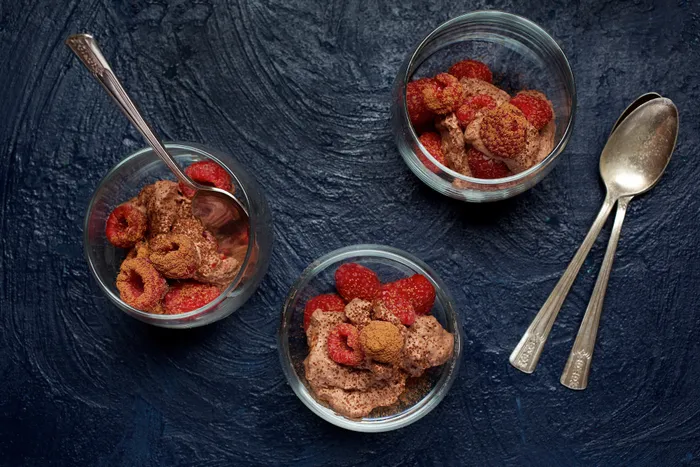How to stabilise whipped cream to keep you and your dessert from weeping

Cocoa powder, as in Raspberries With Cocoa Whipped Cream, above, is another ingredient with starch that can buy you structure in your whipped cream. Photo by Deb Lindsey for The Washington Post.
By Becky Krystal
Desserts are full of ephemeral pleasures, but one of the more fleeting is whipped cream. Pipe decorative swirls, drop artful dollops or spread on as a topping, and then watch as the clock starts ticking. Alas, whipped cream tends to be at its peak for just a few hours. It then starts to weep liquid.
You can, of course, embrace that limited life span and do all your whipping and decorating at the last minute. But that can be a drag when you're prepping a meal for guests, taking a dessert on the road or anticipating having leftovers you'd like to keep in respectable-looking condition.
If you're just working with a past-its-peak bowl of whipped cream, Harold McGee in Keys to Good Cooking says you can either drain off the liquid or fold it back in.
If you want something more stable that also will hold up for a day or two in the refrigerator, you can add a stabiliser. Here are some suggestions. Keep in mind that your first line of defence will be working with very cold cream and, ideally, equipment (bowls, beaters, whisks) that has been chilled as well.
Starch
In Rose's Baking Basics, Rose Levy Beranbaum incorporates a teaspoon of cornstarch into a cup of heavy cream. Over low heat, she brings about a 1/4 cup of the cream to a boil along with one teaspoon cornstarch and two tablespoons confectioners' sugar (which also has starch in it). Then she allows the mixture to cool to room temperature before whipping with the other 3/4 cup of cream that has been refrigerated.
Sweetening your whipped cream with confectioners' sugar will lend some stability, though not as much as using cornstarch. Cocoa powder is another ingredient with starch that can buy you structure. I'm also a huge fan of Stella Parks's food processor whipped cream on Serious Eats, which employs a similar tactic but uses ground freeze-dried fruit as the add-in to absorb moisture and lend stability.
Gelatin
Beranbaum's strategy for using gelatin is similar to her cornstarch method. Swap one teaspoon gelatin in for the cornstarch, bring to a boil with the 1/4 cup cream and two tablespoons of confectioners' sugar and let that cool to room temp. Start whipping the remaining 3/4 cup cream, and when that cream thickens enough that the beater begins to leave marks behind, add the gelatin-enhanced cream and whip to desired stiffness.
Get more dessert tips in the latest IOL Food Digimag here
As described in BakeWise, Shirley Corriher's self-described "sneaky way" gets gelatin into the whipped cream via an almost-melted marshmallow. She suggests one large marshmallow per cup of cream, which you want to quarter and heat either in the residual heat of a warm toaster oven or for just a few seconds in the microwave. The marshmallow pieces should be very soft. Whisk them little by little into your cold, already-whipped cream.
Other dairy
For stability and flavour, you can cut the cream with another type of dairy product. My top pick would be rich and not-really-tart mascarpone. For more pronounced tartness, you can incorporate sour cream. The amount you use will vary depending on how much whipped cream you're making, as well as the flavour and texture you're trying to achieve. Using more of these dairy products will lead to more stable but less airy whipped cream. Feel free to experiment by starting with a tablespoon or two and seeing what kind of results that gets you.
In The Book on Pie, cookbook author Erin Jeanne McDowell shares a recipe for "extra-thick and creamy whipped cream" that is stable for up to 24 hours, thanks to the magic of cream cheese.
For covering a whole 23cm pie, whip 230g of room-temperature cream cheese with a 2/3 cup icing sugar on medium-low until light and fluffy, about 2 to 3 minutes. Turn the speed up to medium, then add the cream in a slow and steady stream down the side of the bowl and beat to medium peaks, stopping to scrape down the bowl when it first reaches soft peaks.
While not strictly dairy, lemon curd is another tasty, effective option that Beranbaum suggests incorporating partway through whipping.
Related Topics: